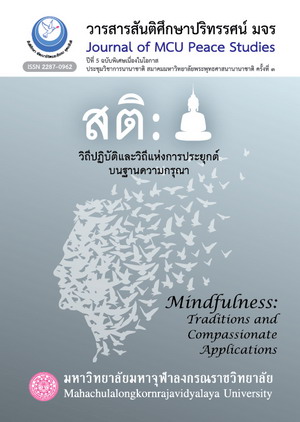The Way to apply Peace Dhamma for enchancing peace of the school youth : A Case study of Rajmontri School (Pleume – Chuamnugoon)
Main Article Content
บทคัดย่อ
This thesis in form of a qualitative-field research done by the tools of documentary study and an in-depth interview with 19 key informants, together withparticipated observation, is of 3 objectives: (1) to study Peace Dhammas for youths evidently shown in Theravada Buddhist Scripture, (2) to study states of problems and school-youths’ violent-behaviors, and (3) to suggest the way to apply Peace Dhammas to school-youth resolution.
From the research, it is found the followings: (1) Peace Dhammas for the youth in Buddhist Scripture: There are 3 Dhammas suit to improve youths, i.e. Sati: Mindfulness, the awareness without carelessness at times of encountering the arousing stimulus or the things agitated the mind, Khanti: Tolerance, the patience of fighting barriers or hindrances in life, and Santi: Peace, having mindful calmness and willingness to sacrifice to calm-heartedly move on. These 3 sections of Dhammas can be applied to develop or improve the youths as the way to create protection, decrease conflicts and violence for youths. (2) The states of problems and conflicts and violence among school-youths in educational institutions: They are mostly found in the manners of un-proper actions and speech as the conflicts between students and teachers, parents and students, including among the students themselves; in view of this, schools and educational institutions resolve in setting up rules and regulations in resolving problem (3) The way to bring Peace Dhammas to apply to develop the youths in educational institutions: It is the mindful practice through meditation prior to studying in that one’s mind will be calm and cool and ready to be developed, got trained in having tolerance with given examples of ones who lacked of it and made such wrong decisions and finished their future; or it can be done by taking the practitioners to the youth detention center to see the outcome of not being tolerant. Lastly is to positive attitudes to the teachers and parents related to the youth training to attain peace in living life in accordance with the Buddha’s teachings.
Article Details
ทัศนะและความคิดเห็นที่ปรากฏในบทความในวารสาร ถือเป็นความรับผิดชอบของผู้เขียนบทความนั้น และไม่ถือเป็นทัศนะและความรับผิดชอบของกองบรรณาธิการ ยินยอมว่าบทความเป็นลิขสิทธิ์ของวารสาร


